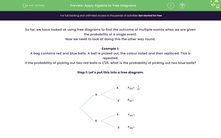So far, we have looked at using tree diagrams to find the outcome of multiple events when we are given the probability of a single event.
Now we need to look at doing this the other way round.
Example 1:
A bag contains red and blue balls. A ball is picked out, the colour noted and then replaced. This is repeated.
If the probability of picking out two red balls is 1/25, what is the probability of picking out two blue balls?
Step 1: Let's put this into a tree diagram:
Step 2: What can we work out?
We know that the probabilities are the same for each event because we are told that the ball is replaced.
If we know that P(RR) = 1/25, this is the same as saying P(R) x P(R) = 1/25 so P(R) = 1/5
Step 3: Work out the other event.
We know that A and B are exhaustive, so P(B) must equal 4/5
Step 4: Complete the rest of the tree diagram.
Step 5: Use this to answer the question.
We were initially asked for the probability of two blue balls. From the tree diagram, we can now see that this is 16/25
Let's move on to some questions now.



 - 001.PNG)
 - 002.PNG)
 - 003.PNG)
 - 004.PNG)




